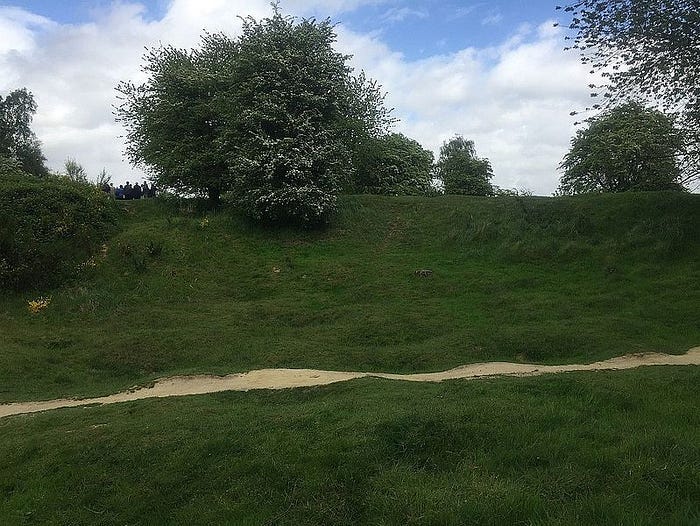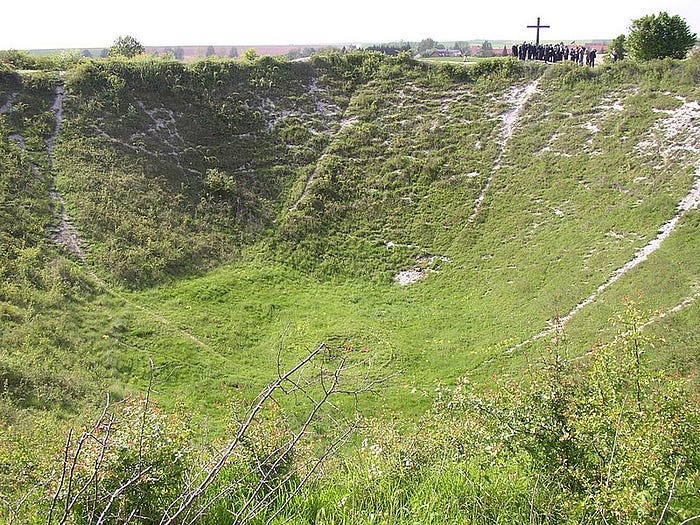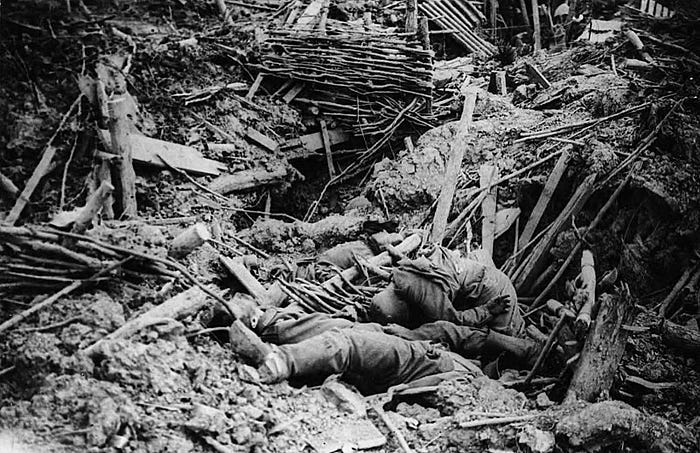The Day The British Army Set Off 470 Tons Of Explosives In One Operation
It created the largest manmade sound ever heard to that point and left scars on the land still visible a hundred years later

“‘Gentlemen, I don’t know whether we are going to make history tomorrow, but at any rate we shall change geography.’ He was right; at, five o’clock the following morning Hill 60 was a valley.”
— The Press and the General Staff, British General Harrington’s briefing on the Messines offensive
Looking at WWI from the veil of history, it’s hard to see it as anything but a meatgrinder. Casualty statistics were so high, the reports seemed like typos. Plus, the front lines barely moved.
The technology of the firepower available at the time far surpassed the tactical abilities of commanders, using skills from generations ago. As author Dan Carlin explains in his book The End Is Always Near:
“The largest artillery pieces of the First World War fired shells that weighed more than Napoleon’s heavy cannons of a century before. And the infantryman’s rifle in 1914 outranged those 18th century horse-drawn artillery pieces.”
Now, this leads to a problem.
Let’s say you’re the British Army and you want to push the Germans off a patch of high ground in occupied Belgium, but they’ve been there for a long time. In that span, they’ve turned it into a fortress manned with machine guns and artillery. Plus, endless soldiers.
This was the case in the Battle of Messines in 1917. Fortunately, in this instance an old tactic did mix well with the modern firepower available. The British chose to tunnel under the fortified structure and destroy it from below like medieval sappers.
Although the modern explosives made the scene resemble something more like the end of the world.
They were also delivered by Britain’s strangest ultimate weapon: sewer workers and a special shoveling technique called “clay-kicking.”
Diggers To The Rescue
Earlier in the war a British officer and peacetime manager of a excavation company, John Norton-Griffiths, advised tunneling would be a way around the present stalemate. In fact, he recommended using his employees. These English sewer workers happened to be the best diggers in the world.
According to the documentary WWI: Tunnels of Death, Norton-Griffiths met with Field Marshal Kitchener and explained the lower portions of the Belgian soil was clay. This was notoriously hard to dig through. Well, except for London sewer workers.

Norton-Griffiths showed how a digger could lay on his back and silently move walls of clay with a team via the clay-kicking technique.
Kitchener was so impressed he instructed the officer to hire as many sewer workers as he could grab. Norton-Griffiths’ team had early successes. They blew up a fortified hill and were able to construct tunnels large enough to move over twenty thousand troops under German lines during one battle.
Vanessa Barford at the BBC says, “Underground warfare was a 24-hour business — shifts worked eight hours on, 16 off.” Moreover, the Germans tunneled as well. So, you had to be totally silent, otherwise an enemy mining team may set a charge near your tunnel and bury you.
By 1916, the sewer workers were augmented with miners and the diggers numbered about twenty-five thousand.
These men spent hours in the dark, in total silence.
They were in danger from cave ins, lack of oxygen, and underground gas.
Occasionally Germans and British broke into each other’s tunnels and hand-to-hand combat broke out in the dark. Not to mention explosive charges.
According to Barford, despite the nonstop stress, the British miners could move twenty-six feet a day, versus seven for the Germans. Their ability made the brash Norton-Griffiths even more audacious.
He proposed what he called “The Great Idea.”
The Great Idea: Creating A Manmade Earthquake
The documentary explains by 1916, the English were looking to push the Germans out of the Messines section of Belgium. Germany was using ports here to launch submarines. Moreover, the flat area would be an excellent causeway for an advance into Germany.
However, the front here hadn’t moved since 1914. The Germans had built a near impregnable fortress, which hurled back assaults.
But Norton-Griffiths saw the German high ground as critically vulnerable to his mining crew. The Belgian soil was watery. But if you got down low enough, you hit clay, which repelled water, and was easy to dig through.
Norton-Griffiths proposed digging twenty-one tunnels — one under each fortress on the Messines ridgeline — and placing massive charges below them. It would literally level everything. Then, add an artillery barrage, and an infantry charge.

The British spent about a year digging, and the Germans discovered them. The English miners retaliated by creating decoy tunnels. These ran above the real ones. To sell the rouse, the miners left devices that regular tapped pick tools to distract the German diggers.
In their effort, the English miners created one of the longest war-time tunnels ever made, which they called “Berlin.” It was about a thousand feet long and a hundred feet deep at points.
By June 7, 1917, the documentary says the British gathered “the greatest quantity of explosives ever assembled by mankind; four hundred seventy tons distributed in nineteen mines.”
Then, the men tensely waited until 3:10AM, when the triggers on the explosives were set off. It’s hard to put what happened next into words.
Cringing In Derelict Shelters ‘Like Beaten Animals’
Nineteen mines were set off near simultaneously, followed by an artillery barrage, and British infantry marched close behind. Even to battle-worn men, the visuals were shocking. Historian Leon Wolf puts it this way In Flanders Fields:
“The earth quaked, tumbling and staggering the British soldiers as they rose in awe to see the rim of the hated ridge burst skyward in a dense black cloud, beneath with gushed nineteen pillars of flame that lit the Salient with the red glare of hell. The pillars fused into greater mushrooms of fire that seemed to set flame to little clouds above. Then, a moment or two later, the long roar of nineteen explosions blended and reverberated into one long blast that stunned even the British troops…”
Wolf says it awakened everyone in the countryside, roared through France, then across the English Channel. The British Prime Minister Lloyd George even heard it…at Number 10 Downing Street in London, over a hundred miles away. But it continued as the British encountered the Germans. Wolf says:
“The enemy was in a state of near shock when the British fell upon them. They surrendered en masse, weeping, waving handkerchiefs, grasping the ankles of their captors. Thousands lay beneath the ground, to be forever entombed there. Some of the mine craters were 300 feet across and 70 feet deep. The wreckage of their front left many Germans cringing in derelict shelters ‘like beaten animals.’”

Michael Duffy at Firstworldwar.com says about ten thousand German soldiers died in the explosion alone, and the British rolled over the former unconquerable ridge easily. The explosion even registered on local seismographs in Belgium and France.
The largest blast driven by over ninety-thousand pounds of explosives created Spanbroekmolen, or “The Pool of Peace.” This is a manmade lake of sorts in the remnants of the crater.

You may have also noticed I originally said twenty-one mines were set. Duffy says two didn’t go off. These were left in the ground after the war. One of which exploded in 1955 taking a cow with it, and the other is still buried.
So, the incredible amount of explosives listed in the title of this article is actually an understatement for what was truly planned.
This whole odd event also gives us another view of WWI as well.
When Your Strategic Plans Involve Creating An Earthquake
In our present day, Vietnam is considered a modern day meatgrinder of humanity and an impetus for a peace movement. During the Vietnam War, the U.S. suffered about 58,000 casualties. Now, let’s go back to WWI.
According to the Encyclopedia Britannica, Britain suffered over 57,000 casualties in one day at the Battle of the Somme. Look at the number again and let that settle in. It was one day, not even the entire battle. So, Britain had multiple Vietnams over the course of one war.
Overall, 35% of Britain’s nine-million-man force were claimed as casualties. Stunningly, this was decent. In France, 73% of the army was listed as casualties. That works out to over six-million men.
Obviously, those outrageous numbers not only darken your view of the conflict, but those managing it too. One vividly imagines lines of bodies flung at machine guns, and that being the only strategy.
Unfortunately, it was that.
But there were also those who thought out of the proverbial box and deemed to make forty-year-old sewer workers their soldiers of choice. A few were even ballsy enough to think they could make the earth shake.
You can still visit remnants of their efforts in Belgium today.
-Originally posted on Medium 5/13/23


